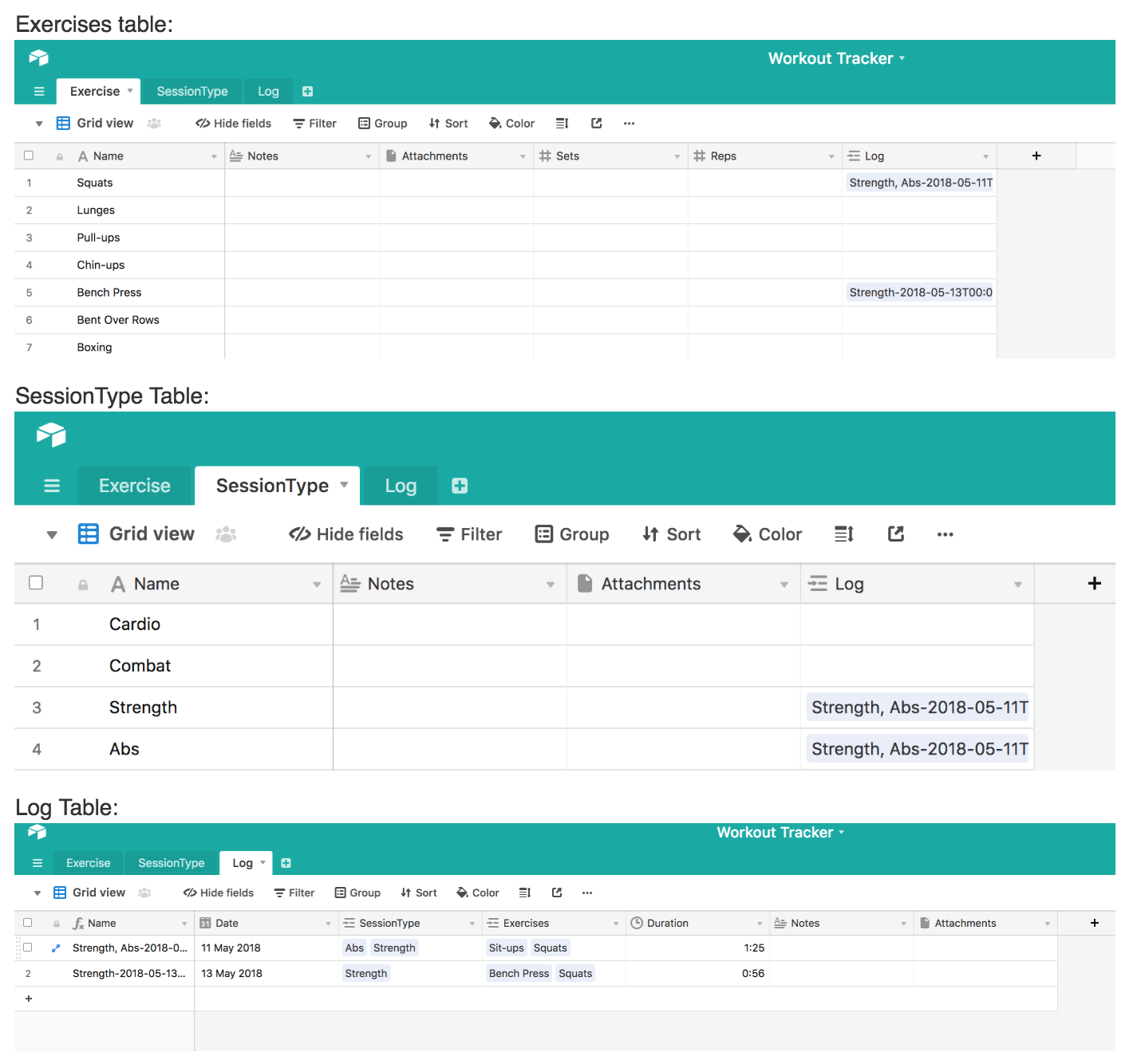Hi fayl,
Instead of pulling the exercises from a table, why not make it a Single select? Then the sets and reps values will be unique to that record.
Then you can remove the exercises table all together.
Bill
Hi fayl,
Instead of pulling the exercises from a table, why not make it a Single select? Then the sets and reps values will be unique to that record.
Then you can remove the exercises table all together.
Bill
@William_Coron Did you mean Multiple select? I tried that but the problem with that is when I convert that column to multi-select, each option doesn’t have fields. It becomes more like a label than an entity with attributes.
@fayl, yes, it will make it more of a tag. Then you can move the attributes like sets and reps, which change, to be part of the log table so they don’t change another person’s sets and reps. Even if you kept exercise as a table with attributes, the sets and reps should belong to the log record, not the exercise record.
@William_Coron Did you mean Multiple select? I tried that but the problem with that is when I convert that column to multi-select, each option doesn’t have fields. It becomes more like a label than an entity with attributes.
Here’s how I’d do it.
I’ve changed the name of your [Log] table to [Session] and made it your main table, with everything else descending from it.
Each [Session] record links to one or more [Exercise] records. (Increasing line height on [Session] to ‘extra-tall’ gives more visibility to the exercises done during each session.) An [Exercise] record consists of the {Exercise} type and the number of {Sets} and {Reps}.
In this case, I’ve changed {Exercise} to a single-select field. However, I can think of reasons why you might wish to keep it a linked record; should that be the case, simply change {Exercise} to a linked-record field pointed at the [ExerciseType] table.
Note: If you go with {Exercise} as a linked record, you should disable links to multiple records. Each {Exercise} record should track sets and reps for a single exercise performed during a specific session. That keeps you from inadvertently stepping on old data.
Conversely, I’ve kept {Session::SessionType} (that is, the {SessionType} field in the [Session] table) as a linked record, but it could just as easily be made a multi-select field.
Clearly, if you decide to track multiple individuals in a single base, you’ll need to create a [Members] table. Each [Members] record will link to multiple [Sessions] records. (You’ll probably want to change the {Name} formulas for the [Session] and [Exercise] tables to include {Member::Name}, looked up from the linked record source.)
P.S. I may have stepped on some of your original base :frowning: , stupidly. The safest way to share bases with such potentially chowder-headed collaborators as I is to post read-only shares with copying permitted; that way, any fiddling about that occurs with the base takes place only within our copies, not your original.
Here’s how I’d do it.
I’ve changed the name of your [Log] table to [Session] and made it your main table, with everything else descending from it.
Each [Session] record links to one or more [Exercise] records. (Increasing line height on [Session] to ‘extra-tall’ gives more visibility to the exercises done during each session.) An [Exercise] record consists of the {Exercise} type and the number of {Sets} and {Reps}.
In this case, I’ve changed {Exercise} to a single-select field. However, I can think of reasons why you might wish to keep it a linked record; should that be the case, simply change {Exercise} to a linked-record field pointed at the [ExerciseType] table.
Note: If you go with {Exercise} as a linked record, you should disable links to multiple records. Each {Exercise} record should track sets and reps for a single exercise performed during a specific session. That keeps you from inadvertently stepping on old data.
Conversely, I’ve kept {Session::SessionType} (that is, the {SessionType} field in the [Session] table) as a linked record, but it could just as easily be made a multi-select field.
Clearly, if you decide to track multiple individuals in a single base, you’ll need to create a [Members] table. Each [Members] record will link to multiple [Sessions] records. (You’ll probably want to change the {Name} formulas for the [Session] and [Exercise] tables to include {Member::Name}, looked up from the linked record source.)
P.S. I may have stepped on some of your original base :frowning: , stupidly. The safest way to share bases with such potentially chowder-headed collaborators as I is to post read-only shares with copying permitted; that way, any fiddling about that occurs with the base takes place only within our copies, not your original.
Wow this is really amazing. Thanks a lot for taking the time to help, I really appreciate it. This was a test project to see if I can use Airtable for anything I do and I feel like I can probably use it for everything!
I’m going to take some time to study this. Out of curiosity, do you know any public bases with reasonable complexity I can look at?
Wow this is really amazing. Thanks a lot for taking the time to help, I really appreciate it. This was a test project to see if I can use Airtable for anything I do and I feel like I can probably use it for everything!
I’m going to take some time to study this. Out of curiosity, do you know any public bases with reasonable complexity I can look at?
I’d suggest grazing through Airtable Universe and/or the Template Collection. If you don’t mind a base with unreasonable complexity, there’s always my Wardrobe Manager.


